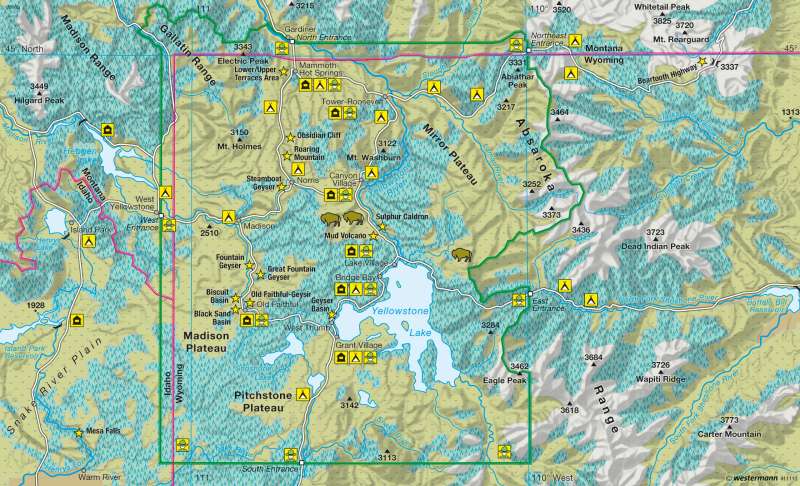Yellowstone National Park
U.S.A. - National parks
978-3-14-100790-9 | Page 145 | Ill. 3

Information
Yellowstone National Park was established in 1872 and is the oldest national park in the world. With an area of approximately 9,000 square kilometres, it is slightly larger than the island of Corsica. About 96 percent of the park area is located in the U.S. state of Wyoming, with a small part attributable to Montana and Idaho. Large parts of Yellowstone National Park cover a plateau of around 2,400 metres and in the centre is North America's largest lake, Yellowstone Lake. Eagle Peak is the highest peak at 3,462 metres. In the national park, there are some 10,000 hot springs, geysers and mud pots. The climate is determined by the location within the Rocky Mountains. The monthly averages in Mammoth Hot Springs range from —13 °C in January and 27 °C in July. In 1976, the National Park became a UNESCO Biosphere Reserve and later, in 1978, a World Heritage Site.Flora and Fauna
About 80 percent of Yellowstone National Park is occupied by coniferous forest. Three-quarters of this is made up of long-needle coastal pines. Spruce and aspen species are also common. Often, a desert sagebrush steppe is spread over non-wooded land.
In the national park there are around 2,000 plant species, including twelve species of trees.
It is a refuge for bison, black bears, moose and elk. Deer, cougars and lynx are also inhabitants here. By 1883, the stock of bison was reduced to around 200 animals. Today, there are approximately 3,500 to 4,000 bison in Yellowstone National Park. After a thorough cull of wolves in the 1930's, 14 Canadian wolves were homed in the park in 1995 to mix with other breeds. The Canadian wolf population has up until today increased to 1,500 animals. This has led to a decline in elk population from between 17,000-19,000 down to 7,000 animals.
Tourism
The foundation of Yellowstone National Park was not out of conservation, but at the forefront as the creation of a public park. For this reason, hunting was banned in 1883 in the mainly hunting orientated tourist areas. After 1915, the first cars were allowed to drive through the park with some 35,800 tourists having visited the protected area by 1916. In 1941, the number of visitors had increased to 581,000 and in 1948; the million mark was exceeded for the first time, followed in 1965 by two-million visitors. Since 1990, between 2.8 and 3.1 million tourists visit the park every year. Today, the visitor will discover opportunities for hiking and mountain climbing, fishing and kayaking, horseback riding and wildlife viewing. In the eleven villages within the park, there are numerous accommodation options. Most places have a "visitor center" or an information station. The peak season lasts from May to October and in July alone, 800,000 tourists visit. During the winter season, only around 140,000 people visit the park.
Tourism is an important industry in the region. In the season, Yellowstone National Park provides approximately 6,800 jobs and in 2005 approximately 300 million U.S. Dollars were earned.
H. Kiegel; Ü: C. Fleming




